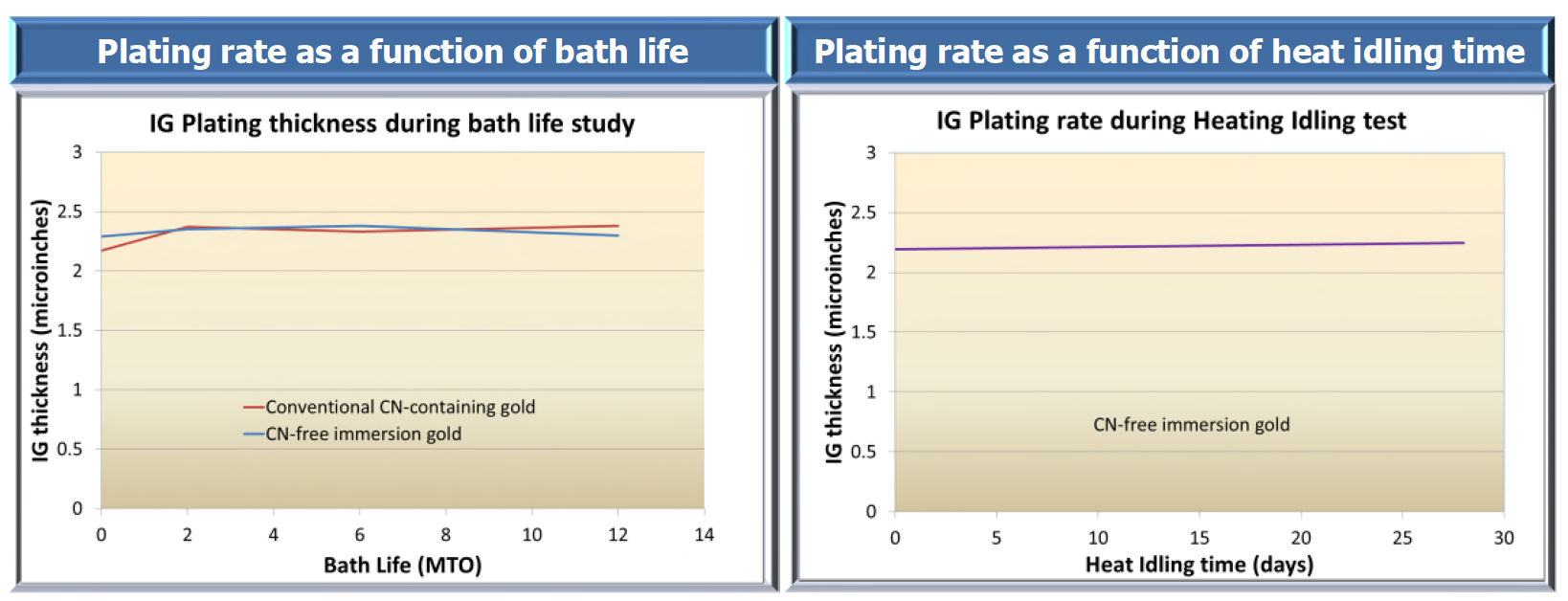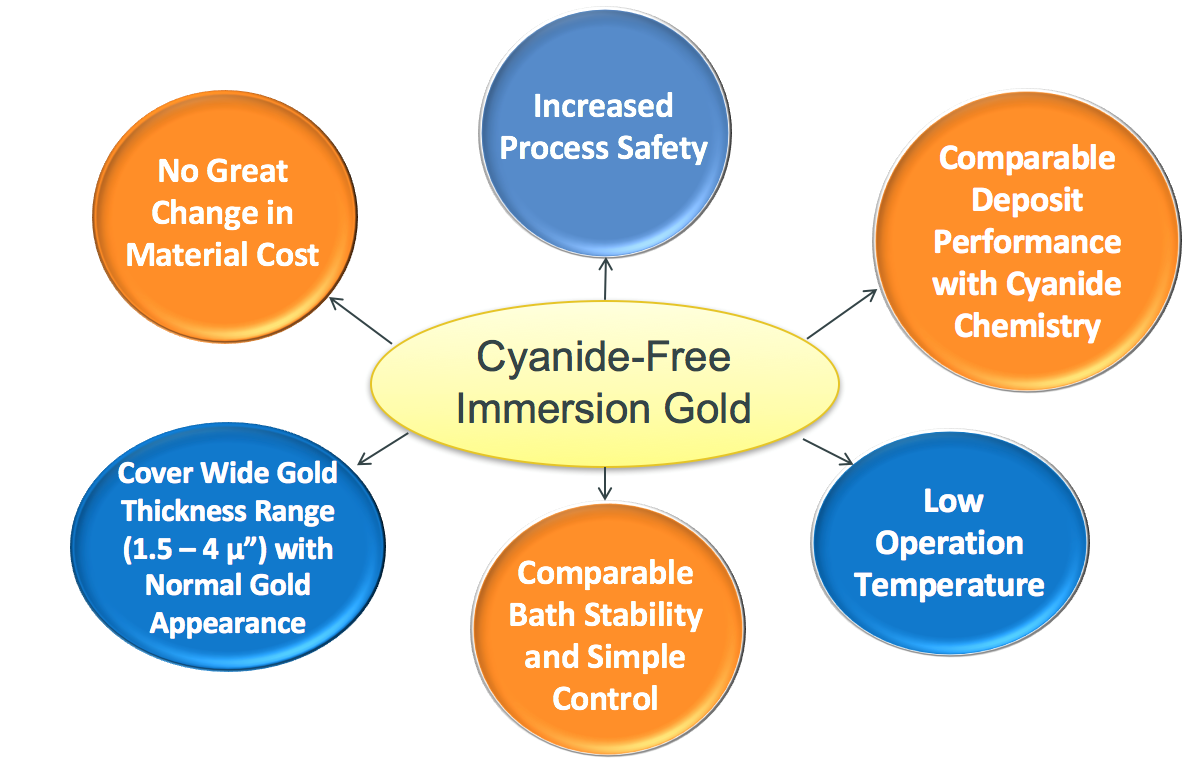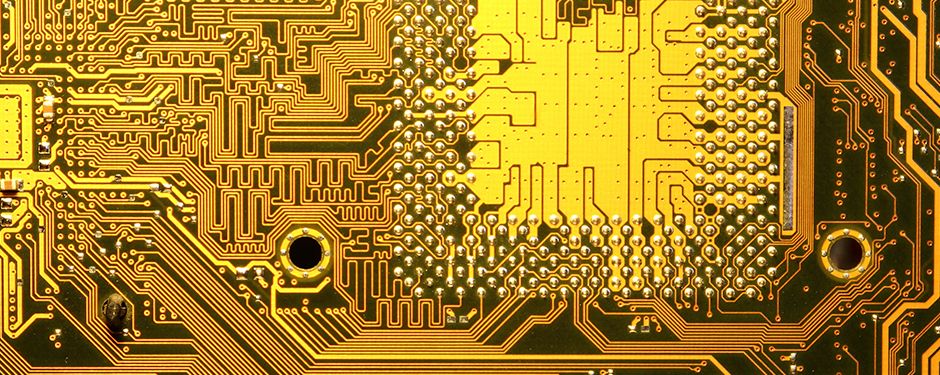Cleaning up PCB final finish: cyanide-free ENIG coatings
May 04, 2017
Electroless nickel immersion gold (ENIG) coatings, used as a final finish for printed circuit boards (PCBs), provide excellent corrosion resistance, high electrical and thermal conductivity, and a reliable surface for soldering and wire bonding. There is, however, a drawback of significant concern: potassium gold cyanide (KAu(CN)2) salt commonly used in the plating bath is toxic, creating an unsafe environment. PCB manufacturers need to handle wastewater very carefully, as even a small amount of residual cyanide can release hazardous fumes.
Many in the industry are dubious about cyanide-free ENIG processes, suspecting that the plating baths may not really be cyanide-free or not trusting the quality of the deposited layers. Initial failed attempts to create cyanide-free immersion gold fueled these concerns. Cyanide-free gold plating does exist and many wafer fabrication facilities use cyanide-free gold sulfites in semiconductor manufacturing. However, for the PCB market, use of cyanide-free gold sulfites is a costly proposition as plating baths are not stable and need to be remade frequently.
Commercially available non-cyanide gold salts do not perform well with the standard immersion plating bath additives as the performance tends to result in gold plating onto the sides of the tank rather than only on the target Electroless Ni surface.
Clearly, there are many potential roadblocks in delivering cyanide-free ENIG processes in PCB manufacturing. However, by using proprietary additives that increase performance and bath stability, Dow has made it possible to create a reliable ENIG surface while avoiding the dangers of using cyanide contained gold salt. These additives enable cyanide-free coatings with the low gold porosity and excellent corrosion resistance expected from standard ENIG coatings.

Figure 1: Deposit performance attributes of Dow’s cyanide-free immersion gold plating bath
The new cyanide-free immersion gold plating bath remains stable after 28 days working bath simulation. The stability of gold deposition rate shows almost no thermal decomposition in heat idling test. Longer bath life of 12 metal turnovers (MTO) translates to lower consumption of chemicals as well as high bath stability. Too short bath life within 5 MTO is the disadvantage of existing cyanide-free immersion gold in wafer final finish process. The PCB industry expects to see bath life of exceeding 10 metal turnovers (MTO), a goal that the new bath chemistry can achieve. Test results demonstrate uniform plating thickness from both fresh and aged baths.

Figure 2: Plating rates for Dow’s cyanide-free immersion gold plating bath show excellent stability.

Figure 3: FIB-SEM analysis shows good corrosion resistance free of abnormal local corrosion when using Dow’s cyanide-free immersion gold plating bath
The new chemistry creates a robust gold surface for soldering with lead-free tin/silver/copper solder. Fracture testing shows ductile failures entirely within the solder joint, while the Ni solder intermetallic layer remains intact.

Figure 4: Normal speed ball shear test shows good solder joint reliability when using a cyanide-free immersion gold plating bath
X-ray photoelectron spectroscopy, a tool that evaluates chemical composition as a surface is etched away, demonstrates the purity of the immersion gold layer. Data from both a fresh bath and one contaminated with copper and nickel to simulate 10 MTO show a layer that is nearly 100% gold, demonstrating that the immersion gold is free from nickel and copper contamination.

Figure 5: Cyanide-free immersion gold plating bath obtains a pure gold layer, free from nickel and copper contamination
Dow’s new cyanide-free plating bath provides an additional benefit over conventional immersion gold plating. A conventional immersion gold bath needs to operate at 80 or 85 ℃ to achieve plating rates that provide sufficient manufacturing throughput. The cyanide-free bath operates at 45 ℃ and can deposit 0.05 µm (2 µ”) of gold in about 10 minutes at this temperature in 1000L scale pilot testing. This lower operating temperature results in much less evaporation, meaning less bath maintenance, as well as lower electricity demand.

Figure 6: Benefits of cyanide-free immersion gold plating relative to current final finish processes
Dow has shown that it is possible to use commercially available cyanide-free gold salts along with carefully developed Dow additives to produce a truly cyanide-free ENIG coating. This coating is safer than conventional ENIG coatings while producing deposits with similar appearance and performance, providing excellent bath stability, keeping materials costs in check, and reducing operating costs by enabling lower-temperature operation.
Interested in learning more? Check out our IMPACT 2016 paper on this topic, titled: High-Performance Cyanide-free Immersion Gold; New Immersion Gold Technology for Uniform Au Thickness Distribution.
Related Information

Copper plating forms critical connections from horizontal RDLs through vertical pillars.

DuPont brings a deep understanding of high-performing materials to enhance printed circuit board materials reliability for flexible and rigid boards.
We’re here to help.
We love to talk about how our electronics solutions can build business, commercialize products,
and solve the challenges of our time.